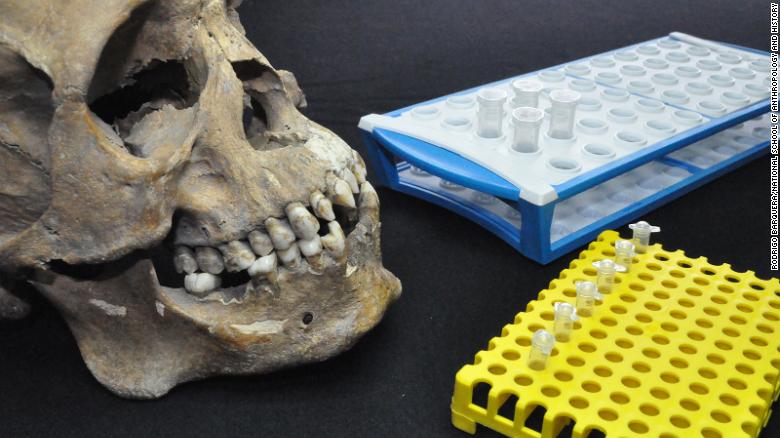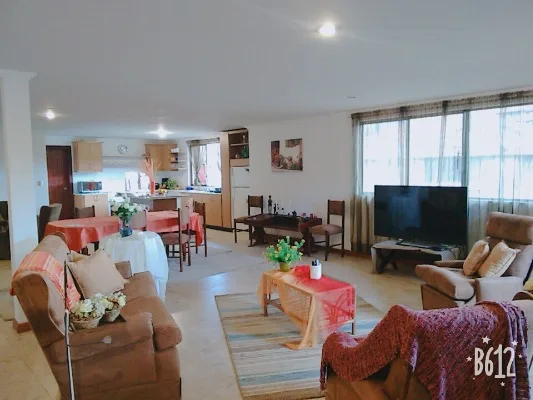The stories these bones tell: Science reveals the history of enslaved Africans in Latin America
By Kristen Rogers
Despite the wealth of knowledge regarding the transatlantic slave trade, the history of enslaved Africans forcibly brought to Latin America has yet to be fully explored.

The skull of one of the individuals studied along with tubes for genetic and isotope testing. Credit: CNN
In a study published Thursday in the journal Current Biology, scientists tell the stories of three 16th-century enslaved Africans identified from a mass burial site in Mexico City, according to analyses of their bones.
African roots may have been invisible in Mexico and Latin America because of the history of the mestizo in Mexico, said first author Rodrigo Barquera, a graduate student at the Max Planck Institute for the Science of Human History in Germany. Mestizo refers to people of white European and indigenous American ancestry.
“The Mexican mestizo celebrated the European and Native American roots coming together very strong after a little bit of struggle, but they usually leave out the African roots when they’re talking about this story,” he added.
Barquera and his team of researchers are hoping that their findings, captured within the bones of these enslaved Africans, will be a step in sharing their stories and addressing the erasure of history in the self-identities of Mexican peoples.
When the researchers noticed modifications on the individuals’ teeth indicating different African cultural practices, they decided to study their genetics and personal histories.
“All of us involved in the study were highly touched by the whole story about these three persons, everything that they went through,” Barquera said.
“Knowing that they were first-generation enslaved Africans brings a new perspective on the whole subject because you know they were abducted. You’re seeing all these maltreatment signatures on the bones that came with this abduction, what they suffered for the rest of their lives.
“Everyone working on this paper was telling us a different part of the whole story. Our results in the end came to a whole story.”
 Colonial Mexico’s role in the transatlantic slave trade
Colonial Mexico’s role in the transatlantic slave trade
More than 500 years ago in 1518, Charles I of Spain authorized retrieving and transporting the first enslaved Africans to the Viceroyalty of New Spain, which ultimately consisted of present day Mexico, the Caribbean, parts of the United States and Canada and Central America except for Panama, the study said.
High demand for enslaved manual laborers and establishment of the first European settlements in what’s referred to as the “New World” spurred the growth and consolidation of the transatlantic slave trade, which forcibly deported 10.6 to 19.4 million Africans from their homelands until slavery was abolished in most of the Americas in the 1860s, the study reported.
Between 130,000 and 150,000 Africans had arrived in the Viceroyalty of New Spain by 1779, when intake of enslaved people into New Spain was banned. New Spain brought in about 70,000 enslaved people between 1600 and 1640, to compensate for a loss of indigenous laborers resulting from casualties during the European conquest and from diseases (smallpox, measles and typhoid fever) that decimated most of the indigenous people.
Africans were thought to have higher resistance to these diseases compared to indigenous Americans and Europeans, which made them desirable workers.
Five centuries later, the study said, the hundreds of thousands of enslaved Africans form a large part of Mexico’s genetic and cultural heritage.
A mass burial site
The San José de los Naturales Royal Hospital was founded in Mexico City between 1529 and 1531.
According to the study, the development of this hospital was to care for the indigenous people of the Viceroyalty of the New Spain, and for victims of smallpox outbreaks that transpired during the early years of the Colonial period.
However, the outbreak abated close to the hospital’s construction, so the bodies in the mass burial associated with the hospital were likely affected by another epidemic, Barquera said.
Finding their bones
The skeletons of the three individuals were recovered from the mass burial site in the grounds near the hospital during the excavations for a new subway line in downtown Mexico City in 1992, under the supervision of two archaeologists who weren’t part of the study.
The mass grave contained skeletal remains of individuals disposed in layers, the study said, which “is consistent with burials made during epidemics, in which dead bodies rapidly outnumber the availability of single graves.”
The bones of all the individuals were transferred to the Osteology Laboratory at the National School of Anthropology and History in Mexico, where little work was performed on them aside from anthropological studies, Barquera said.
In 2012, Barquera and a coauthor began working on the bones as they showed dental modification patterns that were found to indicate different African cultural practices.
“So we were wondering whether we could do a more detailed study on these three individuals, trying to tell the whole story of what happened with them and why they were found in this mass burial in a hospital that was devoted to taking care of indigenous populations and not other populations like Africans or Europeans,” Barquera said.

The skulls and modified teeth of three people taken from Africa and buried hundreds of years ago in a mass grave in Mexico City.Credit R. Barquera & N. Bernal
Three personal histories
The researchers constructed portraits of the lives of the three enslaved Africans using genetic analyses, isotope data (analyses of chemical elements in a structure) and radiocarbon dating (a method for determining how old something is). They also used ethnohistorical information (the study of cultures and indigenous peoples’ customs) and osteobiographies (stories told by a person’s bones).
The three individuals — SJN001, SJN002 and SJN003 — lived from about 1436 to 1626 during the Colonial period in Mexico City, according to radiocarbon dating. Their genetics suggested they were of Southern or Western African origin before being transported to the Americas.
Osteobiographies, stories told by a person’s bones, revealed lives of severe hardship.
“The osteobiography revealed non-specific markers of physiological stress, evidence of occupational stress and healed severe wounds,” according to the study.
Based on evidence of the bones, SJN001 was around 24 years old when he died.
SJN001 showed “abnormal skeletal changes” that “are often in response to conditions associated with diet such as anemia and malnutrition, as well as parasitic infections and blood loss,” stated the report.
His dental health revealed signs of periodontal disease, and bones in his leg appeared to have broken then reformed.
His clavicle also showed new bone development that may have resulted from micro-traumas associated with repetitive use and have been reported to be found among people that carried heavy loads on their shoulders. Parts of the discs in his spine were protruding from compression.
Green coloring and imprinted lines in the part of the spine in the neck and ribs were considered by authors to be the impacts of a gun, and it is believed that the green coloration in his skeleton is from the fragments.
Decorational patterns seen in his teeth are consistent with Fang and other groups from the coastal region of what is now western Africa.
“The patterns seen in the maxillary incisors are consistent with a ‘V’ shaped modification present in Fang and other ethnic groups from the coastal region of central-Western Africa (present day Equatorial Guinea, northern Gabon and southern Cameroon),” the study said.
SJN002 was about age 25 when he died.
He had abscess in a molar, as well as periodontitis and signs of bones that were broken and fractured, then healed. Degenerative diseases damaged his joints. A machete wounded his skull, Barquera said. He suffered skeletal changes as a result of intense and gradual compression on his spinal discs.
Patterns on his teeth were reported in D’Zem people to the east of the Dscha Valley, which is also present-day Cameroon.
SJN003 was also around 25 when he died.
He had lesions on his skull, which could have been caused by malnutrition and anemia, parasitic infections and blood loss and periodontitis. His bones had broken then reformed. He suffered infections in the long bones of his body and a series of skull and leg fractures.
Modifications in his teeth were found in the D’Zem people to the east of the Dscha Valley, or modern Cameroon, but also in an individual studied from Lagos, Portugal.
“This kind of analysis is particularly informative when studying the life history of enslaved people, as much of what we know about their lives comes from records that were kept by their oppressors, which are often considered to be biased and lacking in details about the origins and day-to-day lives of enslaved individuals,” said Éadaoin Harney, a doctoral candidate in organismic and evolutionary biology at Harvard University. Harney was not involved in the study.
Though the injuries were severe, the authors could tell the individuals survived them.
“Within our osteobiographies we can tell they survived the treatment that they received,” Barquera said in a press release. “Their story is one of difficulty but also strength, because although they suffered a lot, they persevered and were resistant to the changes forced upon them.”
Screening for disease
From the remains of the three enslaved Africans, the researchers also recovered the genetic material of two pathogens that infected two of the individuals when they were alive.
SJN001 carried a type of hepatitis B virus typically found in West Africa today, providing the first direct evidence of HBV disease movement with dissemination through the transatlantic slave trade, the study said.
Yaws, a chronic skin infection caused by the bacteria that leads to syphilis, was identified in SJN003 and shares a common origin with a strain found in a 17th-century individual of Colonial Mexico City but carrying European DNA. The strain has also been discovered in West African groups.
The lesions on SJN003’s bones aligned with reported effects of syphilis and yaws. As yaws is associated with poor hygiene, it’s unsurprising that skeletal signs of these diseases have been reported in other African enslaved individuals from similar historic periods in Europe, the study said.
Understanding disease and history
One of the most important implications of the study, which we can see now because of the pandemic, Barquera said, is that travel is almost always implicated in the spread of diseases.
“In this case, we’re seeing two African strains coming into the Americas,” he added. “At least for one of them, we have evidence that it became a very prominent pathogen for some centuries after it arrived.”
Interdisciplinary studies on enslaved people are necessary not only to inform the science and education needed to tell the whole story, but social understanding as well, Barquera said.
“This other root has, for so long, been disregarded as part of the Mexican history,” he added. “And Mexican society deserves to know more about this third root. The social implications of these individuals to be visible again, to be part of this whole history of the Mexican diversity present in modern Mexico [is important].”
______________________
Credit: CNN Space + Science





















